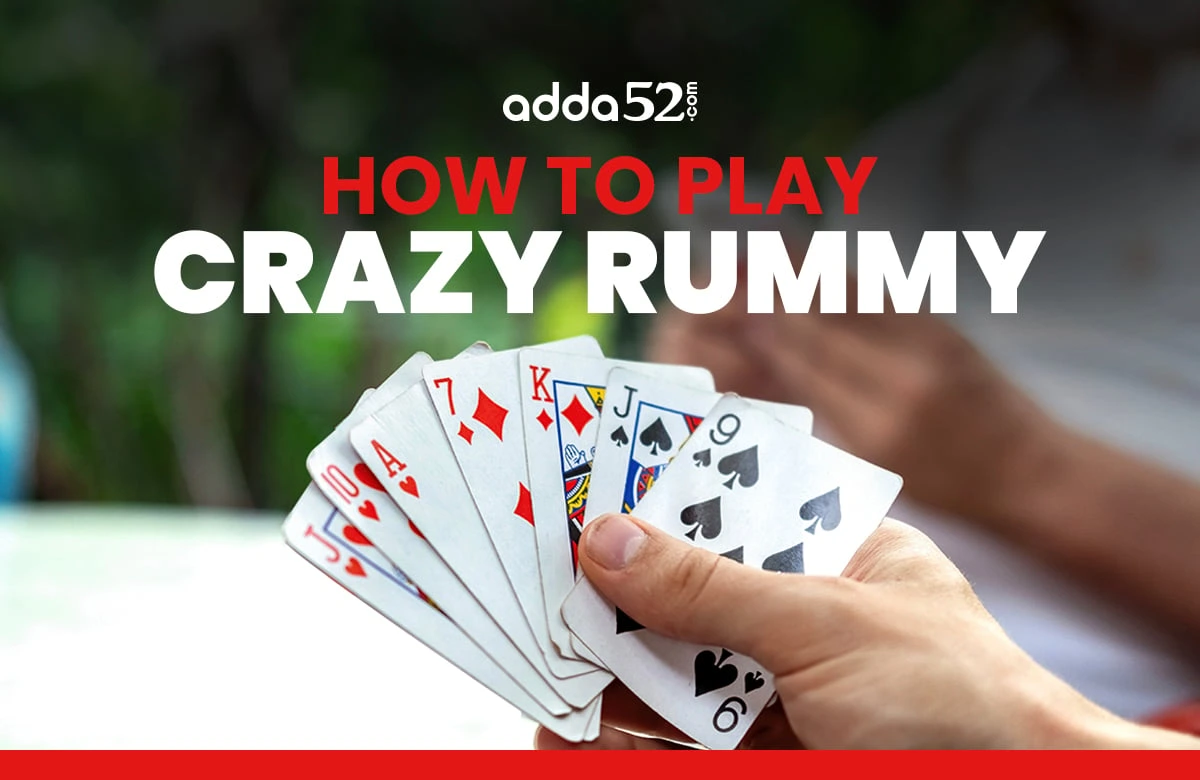
Introduction
Crazy Rummy is a classic card game that promises a lot of fun and excitement. The game revolves around skilfully melding cards into sets or runs; each turn demands a strategic move based on the card's number or face.
This article will help explain the intricacies of Crazy Rummy, from its objective to gameplay, rules, scoring system, and compelling variations. Join us as we explore this dynamic card game for an enjoyable gaming experience.
What Is Crazy Rummy?
Crazy rummy is just another interesting variant of the popular rummy game, which is often played in phases. Each hand is dealt based on the number or face of the card you are on. The objective of the game is to lay down all the cards in hand by arranging them into sets of different suits or runs of the same suit.
Objective and Melds
In Crazy Rummy, the objective for the players is to get rid of all their cards by melding them into sets of various suits or runs of the same suit. One complete game consists of 13 such deals where players aim to complete their sets and runs by melding and discarding cards.
Crazy rummy offers two different types of melds:
- Set: It is a collection of 3 or 4 cards of the same rank, i.e., ♠7-♣7-♥7 or ♦J-♠J-♣J-♥J.
- Run: It is a collection of three or more cards of consecutive ranks of the same suit, i.e., ♦A-♦2-♦3, ♥8-♥9-♥10-♥J-♥Q.
It is important to learn that Aces are ranked low in Crazy Rummy. They are treated as 1 in this form of the game. For example, A-2-3 is a run, while 10-J-Q-K-A-2 or J-Q-K-A are not valid runs.
Each of the 13 deals is played, with one rank being the wild cards. In the first deal, Ace is a wild rank card; in the second deal, 2 is the wild rank card, and so on. In the last and the 13th deal, King is the wild rank card. A wild can be used to complete a run or a set. For example, in the fifth deal, ♦5-♣7-♥7 is a valid set and ♦5-♥8-♥9-♥10 is a valid run.
In a run, the order in which the wild card is placed determines the card it is substituting. In the seventh deal, if a player is holding a ♥7 as ♣5-♣6-♥7, then ♣8 can be added to this run. On the other hand, in the same deal, if the player holds ♥7 as ♥7-♣5-♣6, then ♣8 cannot be added to the run; instead, ♣3 can be added to this run.
If more than one wild card is used to meld a set or a run, the player must clarify the position of the card being used. For example, in the eleventh deal, ♣5-♣J-♥J, this can be either a set of 5s or a run of 5-6-7 of clubs. The player playing this must explicitly highlight the type of meld they want to make.
A set can never have more than four cards, as only four suits are in a deck. For example, in the twelfth deal, ♣10-♥10-♦Q-♠Q, we can not have the third Queen join in the set as only four 10s are possible in the game.
How To Play Crazy Rummy?
Let's break down the gameplay:
Starting the Game:
- The player to the dealer's left goes first.
- They can start by placing groups of cards called melds and then discard a card to finish their turn.
Taking Turns:
- On subsequent turns, players draw a card from the pile on the table.
- They can create new melds or add cards to existing melds.
- The turn ends by discarding a card.
Melding:
- Once you have formed your first meld, the game opens up. Add cards or those of other players strategically to your melds.
Using Wildcards:
- After playing a meld, a player can pick up wild cards from the table and replace them with the actual cards they represent.
Going Out:
- To end the game, discard your final card. If playing a meld leaves you cardless, you can't play that meld.
Single Card in Hand:
- Players with only one card must draw from the stockpile.
- If they can't go out, they discard the card they had and keep the newly drawn one.
Ending the Round:
- The round concludes when a player successfully goes out by playing their last card or if the stockpile is empty.
Crazy Rummy Rules
- Depending on the number of players involved in the game, each player is dealt with either seven or five cards. The remaining cards are kept face down at the centre of the table, known as a drawing pile.
- The topmost card is taken out and kept face up to begin the discard pile. The player to the dealer’s left initiates the game and draws a card either from the top of the drawing pile or the discard pile.
- If possible, this player tries to form a book or set, which he lays face upward before him. He then discards a card to the discard pile. He may create more than one book or set and can draw or discard only one card at once.
- The difference in Crazy Rummy is that you can't play off of another player’s hand. On their turn, each player draws a card from the deck or the discard pile.
- If the drawing pile runs out of stock, the discard pile may be turned face down and shuffled to form a new drawing pile.
- A game is completed when a player lays down all their cards, and no cards are left in the drawing or discard piles. All players then count the total number of cards. The player with the smallest number of points wins.
Scoring
After every round, players earn points based on the cards in their hands, adding them to their total score. A player should avoid scoring points, but when they go out, they get zero points for that round.
Wild cards are worth 25 points, Aces are worth 1 point, numbered cards are valued based on their number, and face cards (Jacks, Queens, Kings) are all worth 10 points each.
Variations of Crazy Rummy
Crazy Rummy is a versatile card game with multiple rule variations. Here's a simplified overview of some common variations:
Player Count and Decks:
When two or three players participate, ten cards are dealt to each.
A double deck of 104 cards is used in games with more than four players.
Set Composition:
Sets can include duplicate cards; for instance, having two of the same cards in a set is acceptable.
Sets with wild cards can exceed eight cards, even if the excess cards do not represent real cards in the deck.
Dealer Rules:
In some versions, the dealer receives eight cards and plays first instead of the player to the dealer's left.
First Turn Melding:
Some groups prohibit the first player from melding on their initial turn. They must discard a card and wait for the next turn to create sets or runs.
Wild Card Handling:
There is a variation when a player claims a wild card from the table. Some insist on immediate reuse in a meld, while others allow storage in the player's hand.
Special Rules for One Card Left:
Some versions omit specific restrictions for a player with only one card left, possibly as an oversight or due to group preferences.
Stockpile and Discard Pile:
When the stock pile is exhausted, some play that the discard pile is shuffled and forms a new stockpile. The player drawing the last card initiates the new discard pile.
Scoring Variations:
Wild cards may score 15 or 20 points instead of the standard 25.
Jacks, Queens, and Kings might be scored 11, 12, and 13 points, respectively.
Penalty Points Doubling:
In some games, when a wild card is a 7 or King, all penalty points for that hand are doubled.
Outgoing Player Bonus:
Rather than scoring zero, the player who goes out receives a bonus (e.g., 15 points), while other players add the value of the remaining cards to their scores.
These variations add excitement and adaptability to Crazy Rummy, making it an enjoyable game with diverse house rules.
End of Game
In Crazy Rummy, the game typically ends when a player successfully forms their entire hand into valid sets or runs and discards their last card. The other players then reveal their cards, and the points are tallied. The player with no remaining cards scores zero points for that round, and the others score penalty points based on the cards left in their hands.
Crazy Rummy Tactics
Sometimes, it is wise to hold onto strong card combinations rather than playing them immediately. This approach can restrict the options available to other players, which makes it more challenging for them to succeed. However, if one of these players manages to win, you could end up with higher penalty points because you chose not to lay down your higher cards quickly. It is particularly crucial in games with five or six players, where you may have only a couple of turns before someone goes out.
Often, players discard their highest cards when they can't use them, which helps reduce the penalty points they might receive at the end. It also allows other players to hold onto their high cards, potentially creating sets or runs with the discarded high cards.
Some players strategize by placing a combination that includes a wild card while keeping a card that allows them to bring that wild card later in the game. For instance, if Jacks are wild and you have ♥♠ 2♣-3♣-4♣-J♦ in your hand, you can lay down J♦, 3♣, and 4♣ as a run while saving 2♣ with yourself for later. This way, you benefit from the wild card without the risk of being caught with it if another player goes out before you are able to finish your turn.
A player aiming for a low score might play with low card combinations to support another player who has also kept low cards. This tactic can help that player win, which may leave other players with more cards at the end.
Frequently Asked Questions
How do you play a Crazy card game?
Crazy Rummy can be played by shuffling and dealing cards, forming sets or runs, and aiming for a full hand. Strategically discarding cards and being the first to go out. Score points based on unplayed cards. The player with the lowest score wins.
What are the Crazy Rummy rounds?
Crazy Rummy consists of multiple rounds. Players aim to complete their hand according to set rules in each round. Scoring occurs at the end of each round, with points added for unplayed cards. The player with the lowest cumulative score after all rounds is the winner.
Conclusion
Whether you are a seasoned pro or a curious beginner, Crazy Rummy promises a dynamic game filled with twists, turns, and unpredictable moments. Play a game of Crazy Rummy today!
